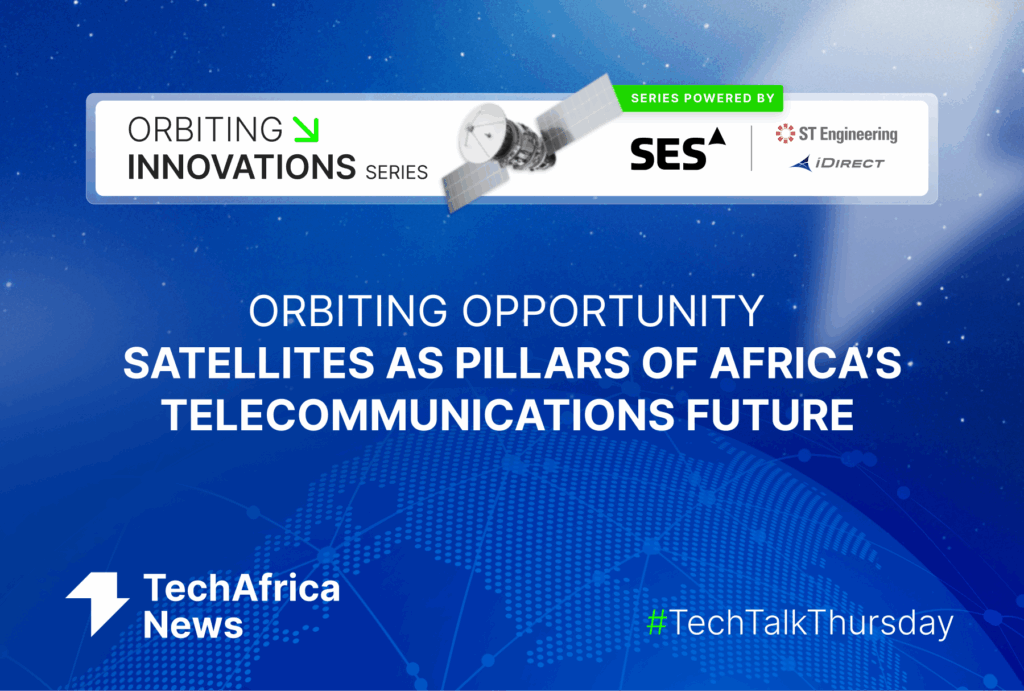Orbiting Opportunity: Satellites as Pillars of Africa’s Telecommunications Future
Africa’s digital transformation depends on reliable connectivity. Yet large parts of the continent, especially rural and remote communities, remain beyond the reach of traditional telecommunications infrastructure. Satellite technology is no longer a secondary option. It is becoming a central component in building a more inclusive and functional digital ecosystem across Africa.
The challenges facing terrestrial network expansion are well known. Fibre optic cables and cellular towers require significant investment, careful planning, and stable geography. Many African regions lack all three. The population is often dispersed, terrain is difficult, and returns on investment are uncertain. These limitations have delayed the continent’s efforts to close its connectivity gap. Satellite systems respond directly to these constraints, offering scalable coverage to locations that ground infrastructure cannot reach.
Cellular Backhaul and Remote Access
One of the most significant contributions of satellite technology to Africa’s telecommunications infrastructure is its role in cellular backhaul. In areas where deploying fiber is economically prohibitive, satellite links provide the vital connection between cellular base stations and the core network. This enables mobile operators to extend their reach, bringing essential voice and data services to previously unconnected or underserved communities. Companies like Africa Mobile Networks (AMN) are actively using Starlink’s low Earth orbit (LEO) satellites for backhaul, connecting thousands of mobile network base stations across sub-Saharan Africa and enabling 3G and 4G services in remote areas. For some villages, this is the first time residents can make a mobile call without having to climb hills or walk kilometers to the nearest tower.
Reaching the Last Mile with Direct-to-Device Access
A more recent breakthrough, Direct-to-Device (D2D) satellite communication, is also transforming connectivity. This approach allows mobile devices to connect directly to satellites without relying on terrestrial infrastructure. It removes the need for ground-based towers, backhaul links, or even local internet providers. The result is a new form of accessibility that is immediate, borderless, and especially relevant to underserved communities across Africa.
For example, In Nigeria, the National Space Research and Development Agency (NASRDA) is working with China’s Galaxy Space to deploy D2D capability across the country. The goal is to eliminate mobile network blind spots entirely by the end of 2025. In South Africa, a successful demonstration was conducted in March 2025, when MTN and LEO satellite provider Lynk Global completed the continent’s first satellite-to-mobile phone call. These initiatives are perhaps the clearest signal yet of a paradigm shift in how Africa approaches last-mile connectivity.
D2D services are not theoretical. They are already being commercialised. YahClick, a subsidiary of Al Yah Satellite Communications Company (Yahsat), launched Skyphone, a satellite-enabled mobile device service that allows users in remote areas to make voice calls, send SMS, and access essential services via satellite without relying on local telecom infrastructure. Skyphone works by connecting directly to Yahsat’s satellites, operating on a narrowband frequency designed to support reliable, low-power communications in even the most remote environments. It is being positioned as a lifeline for off-grid populations, emergency responders, and rural entrepreneurs who have been historically cut off from digital tools.
“Direct-to-device is a major trend in the satellite industry. We have joined the Mobile Satellite Service Association to work with key players and optimize spectrum use. Yahsat’s strategy includes launching Skyphone and Sky SMS, allowing standard handsets to send SMS to satellites. Our Blue Star strategy envisions a full D2D constellation in the coming years. Skyphone, already well-received in Africa, provides connectivity even in remote or disconnected areas, ensuring users stay connected.”
— Sulaiman Al Ali, CCO of Yahsat and CEO, Thuraya
The Role of LEO Constellations
The increasing deployment of Low Earth Orbit (LEO) satellite constellations, such as Starlink, OneWeb, Amazon’s Project Kuiper, and SES’s O3b mPOWER, has fundamentally reshaped the telecommunications landscape in Africa. Unlike geostationary (GEO) satellites, which orbit much higher, LEO satellites operate closer to Earth (500–2,000 km), offering significantly lower latency and higher bandwidth. This translates into a more responsive internet experience, making satellite broadband a competitive alternative even in more densely populated areas. Starlink, for instance, has entered over twenty African countries, often through partnerships with mobile operators like Airtel Africa, to improve connectivity access.
Connectivity That Serves More Than Just the Internet
Beyond direct internet access, satellites are pivotal in supporting various sectors that rely on robust telecommunications. In healthcare, satellite-enabled telemedicine services allow remote consultations and diagnoses, improving access to medical care in underserved regions. In Northern Kenya, for instance, a nurse at a remote clinic can now connect with a cardiologist in Nairobi within minutes—avoiding days of travel and delay. It is hard to overstate the impact this has on rural health outcomes.
The iMlango project in Kenya, utilizing Avanti Communications’ satellite broadband, has brought digital learning tools to rural schools, significantly improving educational outcomes. In agriculture, satellite imagery and connectivity facilitate precision farming, enabling optimized irrigation, crop monitoring, and climate resilience. And when it comes to disaster management, satellites provide early warning systems for events like droughts and floods, and help deploy high-speed internet services during relief efforts when traditional infrastructure is unavailable or destroyed.
Building Forward with Satellite and Terrestrial Synergy
While the benefits of satellite connectivity are increasingly evident, challenges remain. High service costs, regulatory bottlenecks, and uneven access continue to slow progress in many regions. To address this, policymakers, service providers, and regulators must work in coordination. That means creating supportive licensing frameworks, encouraging infrastructure-sharing models, and introducing targeted subsidies that make satellite solutions more affordable and scalable.
And the good news is that the telecommunications industry is not treating satellite innovation as a competing force. Rather, operators are embracing a complementary model. Satellite networks are not replacing terrestrial systems. They are expanding their reach, filling critical coverage gaps, supporting enterprise backhaul, powering home broadband, and enabling direct-to-device services in areas traditional infrastructure cannot serve.
As Ralph Mupita, President and CEO of MTN Group, explained in a TechAfrica News Podcast episode,
“I see LEO and non-terrestrial networks as an opportunity—one we must all embrace. We’re moving into a world where we are always connected. Whether we’re climbing Mount Kilimanjaro or floating in the middle of Lake Victoria, connectivity will just be there. Satellites aren’t here to replace terrestrial networks. They’re here to complement them, especially in remote regions and over water bodies where traditional infrastructure can’t reach. At MTN, we see this playing out in three clear ways: enterprise backhaul, home broadband, and direct-to-device connectivity. Even as satellite operators move toward delivering services directly to consumers, this isn’t a threat—it’s an evolution. One that pushes all of us to reimagine infrastructure, access, and reach.”
— Ralph Mupita, CEO and President, MTN Group
Africa’s digital transformation requires all tools at its disposal. Satellite innovations have emerged as essential components in that effort, linking the unconnected, supporting national development priorities, and enabling public services in ways that were previously impossible. As technology advances and collaboration deepens, satellites will continue to play a catalytic role in shaping Africa’s telecommunications infrastructure and expanding the promise of digital inclusion for all.





